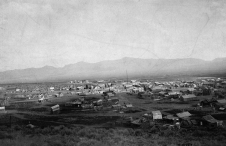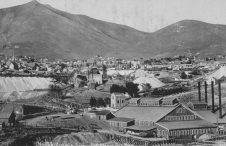Chinese and Mining
Shortly after the news of the discovery of gold at Sutter's Fort in 1849 reached South China, Chinese gold seekers flocked to the Mother Lode in California. These men eventually migrated to the area now known as western Nevada. Present-day Dayton was originally called "Chinatown" because the Chinese had settled there in the 1850s in considerable numbers.
In 1859 in Gold Canyon, some fifty Chinese reportedly earned over $35,000 from gold mining. Their ever-increasing presence led to the adoption of the June 11, 1859 mining regulations for the Gold Hill Mining District that forbade Chinese from holding a claim. Consequently, those who did not placer mine in the immediate vicinity took up service-oriented jobs and some became prosperous restaurant and laundry owners. Lee Kee (1824-1931) had gone to Gold Canyon in the early 1850s and eventually settled as a restaurant owner in Austin, Lander County, until his death at the age of 107.
Although other mining districts followed Gold Hill's lead of discrimination, eventually individual Chinese miners and Chinese American mining conglomerates bought claims that had been abandoned or sold to them by Euro-Americans. Some Chinese worked for mining companies. In 1869, Silver Peak had one hundred miners, forty of whom were Chinese, and eventually one of them became mayor of the little town.
During the early period when Nevada relied on mining, the industry's labor force was about twenty percent (8,300) of the state's population. Of the 3,152 Chinese in the state in 1870, only 240, or eight percent, gave their main occupation as miners. The statistics are probably flawed, but they indicate general trends.
With great perseverance and funds from the prosperous Chinese in San Francisco, some succeeded in placer and hard rock mining, especially in American Canyon, Winnemucca, and Tuscarora. In its heyday, Tuscarora, Elko County, boasted more than a thousand Chinese, many of them successful gold miners, and many working alongside other ethnic groups. Estimates of Chinese production between 1869 and 1870 range from $700,000 to $7 million, with salaries as high as $15 per day. By 1880, Tuscarora had two Chinese assayers and some of its gold probably was shipped through the Bank of Canton in San Francisco to South China. In the nearby mining community of Island Mountain, Elko County, Chinese miners represented fifty to ninety percent of the town's population and learned to live in relative harmony with the Shoshone and Euro-Americans between 1873 and 1920.
The Chinese continued their interest in mining in the twentieth century. Sam Yet of Searchlight and Frank Chang of Lovelock were two examples of men who pursued their gold seeking dreams.
The Chinese participated in other types of mining. Billy Min Chung Ford (1850-1922) was a borax miner and labor boss who made his home in Tonopah. Many Chinese were involved in borax mining in Candelaria and the Columbia Marsh. Some Chinese participated in copper mining, but most pursued gold mining and instant wealth.
Article Locations
Related Articles
Further Reading
None at this time.


